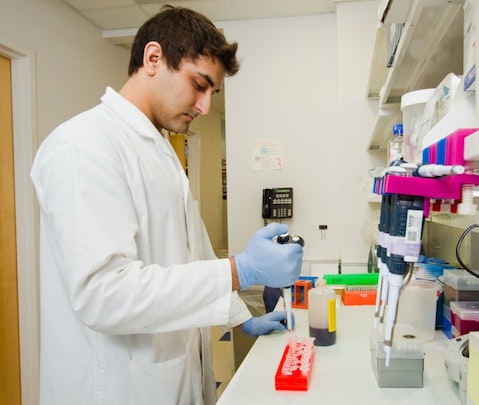Compugen Ltd. (NASDAQ:CGEN) Q2 2023 Earnings Call Transcript August 7, 2023
Operator: Ladies and gentlemen, thank you for joining us today. Welcome to Compugen’s Second Quarter 2023 Results Conference Call. At this time, all participants are in a listen-only mode. As a reminder, today’s call is being recorded. An audio webcast of this call will be made available on the Investors section of Compugen’s website, www.cgen.com. I would now like to introduce, Yvonne Naughton, Head of Investor Relations and Corporate Communications. Yvonne, please go ahead.
Yvonne Naughton: Thank you, operator, and thank you all for joining us on the call today. Joining me for Compugen for the prepared remarks are Dr. Anat Cohen-Dayag, President and Chief Executive Officer; and Alberto Sessa, Chief Financial Officer. Dr. Henry Adewoye, Chief Medical Officer; and Dr. Eran Ophir, Chief Scientific Officer, will join us for the Q&A. Before we begin, we would like to remind you that during this call, the company may make projections or forward-looking statements regarding future events, business outlook, research and development efforts and their potential outcome, the capabilities of the company’s discovery platform, anticipated progress and plans, results and timelines for its programs, financial and accounting related matters, including projected financial information, as well as statements regarding the company’s future cash position and other results, and the company’s future initiatives.
We wish to caution you that such statements reflect only the company’s current beliefs, expectations and assumptions, but actual results, performance or achievements of the company may differ materially. These statements are subject to known and unknown risks and uncertainties, which could cause the company’s actual results to differ materially from those projected in such forward-looking statements. And we refer you to the SEC filings for more details on these risks, including the company’s most recent annual report on Form 20-F, filed with the SEC on February 28, 2022. The company undertakes no obligation to update projections and forward-looking statements in the future. And now, I’ll turn the call over to Anat.
Anat Cohen-Dayag: Thank you, Yvonne. Good morning and good afternoon, everyone, and welcome to our second quarter 2023 update. At Compugen, our goal is to transform the treatment of cancer patients who have no effective treatment options by discovering novel drug target and developing potential first-in-class drugs. On this prompt, we were efficiently executing on our differentiated clinical approach to evaluate the benefit of our chemotherapy-free triple cancer immunotherapy combination of COM701, COM902 and pembrolizumab, blocking free pathways of the DNAM axis PVRIG, TIGIT and PD-1. At ASCO this year, we were excited to see the positive momentum and interest of the industry and the scientific community in targeting the DNAM-1 axis as a potential novel approach in treating cancer, reflected by our own data and data presented by others, including AstraZeneca, Roche and ARCUS/Gilead.
Looking at the totality of the data we have presented to date in how to treat cancer patients, there was enthusiasm among those we spoke with regarding responses demonstrated with our triple combination approach in patients with microsatellite stable endometrial cancer, who had failed standard of care, including prior pembro and lenvatinib treatment. For these patients, there were no other treatment options. In naïve patients, we showed an overall response rate of 22% and a disease control rate of 44%. The responses were durable and supported by immune activation better than what one would expect for an anti-PD-1 alone. This endometrial data is consistent with the antitumor activity we reported for COM701 based combinations in patients with other hard to treat tumors, including microsatellite stable colorectal cancer, platinum resistant ovarian cancer and checkpoint inhibitor experienced non-small cell lung cancer patients.
Reflecting on the totality of the data to date, in patients typically not responsive to standard of care, including immunotherapy, our data suggests that our COM701 based combinations have the potential to offer a treatment option with a favorable safety profile for how to treat patients across the spectrum of PD-L1 expression levels, in patients who are anti-PD-1 treatment refractory, pointing to a potential COM701 mediated mechanism of action. Our immediate focus is on expanding our data in 2 indications, platinum resistant ovarian cancer and MSS colorectal cancer, while continuing to invest in biomarker discovery, which is important in efficiently setting our development path forward. However, we believe that the therapeutic potential of COM701 as part of the DNAM-1 axis maybe much broader than these 2 indications.
As mentioned earlier, AstraZeneca presented clinical results at ASCO on rilvegostomig, a PD-1/TIGIT bispecific antibody derived from COM902, establishing its safety and pharmacokinetic profile and showing anti-tumor activity in patients previously exposed to checkpoint inhibitors and usually not responsive to immunotherapy. AstraZeneca continues to advance rilvegostomig development in multiple studies including a Phase 2 trial in checkpoint inhibitor or naïve non-small cell lung cancer patients and a Phase 2 trial in hepatobiliary cancer and previously announced plans to initiate a Phase 3 trial this year. We know that not all anti-TIGITs are designed the same and like COM902, which is an anti-TIGIT with reduced Fc effector function with rilvegostomig was engineered to have an inactive Fc domain to enhance antitumor activity.
Another program in this Fc inactive or reduced effect of function camp is ARCUS anti-TIGIT. At ASCO, ARCUS/Gilead showed continued improvement in progression-free survival versus blocking PD-1 alone with the potential better safety profile to what has been shown to date with Fc-active anti-TIGIT. Another session that’s gained great interest at ASCO was Roche TIGIT liver cancer data. This is the third randomized trial showing the benefit of adding an anti-TIGIT to standard of care. Blocking TIGIT resulted in a 4-time greater overall response rate and a doubling the progression-free survival on top of standard of care and Roche has initiated a Phase 3 trial in first line hepatocellular cancer based on these results. We were pleased that the discussant of Roche presentations highlighted the potential significance of adding PVRIG blockade in hepatocellular cancer.
This is another hard to treat indication which may serve as a fit for COM701 treatment. The important role of PVRIG was also called out in another ASCO session on novel approaches to checkpoint inhibitors, in which the presenter was intrigued by our data presented by Dr. Mike Overman from MD Anderson at SITC last year, showing that blocking PVRIG in combination with PD-1 led to responses in unexpected diseases like microsatellite stable colorectal cancer. It is great to see an increased awareness of PVRIG role in cancer immunotherapy. It is important to highlight Compugen’s differentiated approach and how we stand out among all the players. Firstly, we have always said that blocking TIGIT may not be enough and that PVRIG may be needed. Our discovery of PVRIG and the extensive research, we have conducted to test the effect of unlocking its biological function as a new drug target in the context of the DNAM axis support the need to block it.
This belief is consistently being reinforced as we rollout our clinical data across multiple indications. Secondly, we believe we have a potentially best-in-class reduced Fc-effective function anti-TIGIT. The data available today suggests that Fc design of the TIGIT antibody may either not matter or it may be better to have a reduced or inactive Fc domain as we have. And finally, with COM701 and COM902, our 2 wholly-owned PVRIG and TIGIT programs were the leaders in the unique chemotherapy free triple combination approach of blocking 3 DNAM axis immune checkpoint PVRIG, TIGIT and PD-1, with initial clinical data to support our hypothesis. Along with a very successful ASCO, I would like to refer to additional progress we have made in the first half of the year.
We’re advancing patient enrollment in our 2 follow-on proof-of-concept studies. Enrollment in the MSS CRC study is on track to be completed by the end of the year. Enrollment is slower than planned in the platinum resistant ovarian cancer study, but we believe we can catch up on enrollment with a planned activation of additional sites. As a reminder, the goal of these studies is to obtain more data, help us better understand the contribution of components and build on extensive biomarker work to identify the patients most likely to respond. We believe that this strategy provides the fastest way to efficiently set our development path forward and to potentially de-risk our lead assets COM701 and COM902 in these two indications. In May of this year, we presented data on our potential first-in-class anti-IL-18 binding protein antibody COM503 at a CIMT Conference, Europe’s Annual Immunology Conference.
We believe there is excitement around our innovative approach leading to the development of this COM503 program and its potential in addressing immunotherapy resistance. Finally, on the progress in the first half of 2023, we were delighted with the favorable ruling of the European Patent Office to uphold the broad claims in our PVRIG patent. This ruling of the European Patent Office is a win for our innovation, the discovery of PVRIG’s role as a novel immune checkpoint and a drug target for cancer. As a company that excels in the discovery of new drug targets, we harness the broad patent strategy that takes advantage of our novel target discovery capability. Now, moving on to what you should expect to see from us over the second half of the year.
First, we plan to report initial findings from our ongoing proof-of-concept studies by the end of the year and final data at a medical conference in 2024. Second, we’re expecting to present new translational and initial biomarker data and long-term patient follow-up from our platinum resistant ovarian cancer studies presented at ESMO-IO last year, as well as additional data from our COM503 preclinical program all by the end of the year. We also plan to present new data from the metastatic breast cancer study of 17 patients treated with COM701 and nivolumab. Patients were enrolled into this cohort regardless of their ER/PR and HER2 status. These patients were heavily pretreated and had exhausted all available standard treatments, which could include immune checkpoint inhibitors and ADCs. Before handing over to Alberto, I will touch briefly on our finances, and then Alberto will go into the details.
We have an expected cash runway through at least the end of 2024, which we believe is sufficient to support all planned operations and reach milestones to potentially de-risk our lead assets COM701 and COM902. In terms of future funding, non-dilutive funding of our pipeline assets is our priority. On this front, it is worth noting that the trend in immunotherapy is to combine and treat earlier, and we believe the profile of our lead assets COM701 and COM902 make them ideal combination candidates to be used in earlier treatment settings. Additionally, there is increasing excitement around the potential of IL-18 pathway modulation in immunooncology. And with COM503, we’re happy that we have a differentiated approach to potentially harness this cytokine biology for optimal use in treating cancer.
Finally, through our partnership with AstraZeneca, we may become eligible for future milestone payments. And with that, I will hand over to Alberto for the financial update.
Alberto Sessa: Thank you, Anat. I’m happy now to summarize our financial results. I will start with our cash balance. As of June 30, 2023, cash, cash equivalents and cash investments were approximately $66.5 million, compared with approximately $83.7 million as of December 31, 2022, affirming our focus on capital efficiency while continuing our execution on our DNAM-1 axis hypothesis. The company has no debt. We recognize the importance of cash efficiency, and we are disciplined in how we deploy our cash resources, ensuring we will focus on reaching key milestones with our available cash runway through at least the end of 2024. Expenses for the second quarter of 2023 were in line with our plans. R&D expenses for the second quarter of 2023 were $7.8 million, up from $6.8 million in the second quarter 2022.
The increase is mainly due to the end of the amortization of deferred participation in R&D expenses on March 31, 2023, and an increase in preclinical and CMC activities associated with plan COM503 activities offset by a decrease in clinical trial expenses, headcount, and currency exchange effect. Our G&A expenses for the second quarter of 2023 were $2.4 million, compared to $2.6 million in the second quarter of 2022. For the second quarter of 2023, net loss was $9.3 million, or $0.11 per basic and diluted share, compared to a net loss of $9.1 million, or $0.11 per basic and diluted share in the second quarter of 2022. With that, I will hand back to Anat to summarize.
Anat Cohen-Dayag: Thank you, Alberto. To summarize, we continue to execute and deliver on our goals. With our most recent data in microsatellite stable endometrial cancer, we continue to provide evidence supporting a potential COM701 mediated clinical benefit in how to treat patients who are not responding to standard of care and failed prior IO therapy. We’re looking forward to presenting new translational and initial biomarker data and long-term patient follow-up from COM71 combinations in ovarian cancer, first data in metastatic breast cancer as well as additional data from our COM503 preclinical program, all by the end of the year. We also plan to share initial findings from our 2 ongoing studies in microsatellite stable colorectal cancer and platinum resistant ovarian cancer, evaluating a leading triple combination blow case of PVRIG, TIGIT, and PD-1 with COM701, COM902 and pembrolizumab by the end of the year.
The opportunity we have to positively impact the lives of so many motivates every single employee within Compugen every day. With that, I will turn the call over for questions. Operator?
See also 10 Most Undervalued Cybersecurity Stocks To Buy and 25 Believable Excuses for Missing Work on Short Notice.
Q&A Session
Follow Compugen Ltd (NASDAQ:CGEN)
Follow Compugen Ltd (NASDAQ:CGEN)
Operator: Thank you. Ladies and gentlemen, at this time, we will begin the question-and-answer session. [Operator Instructions] The first question is from Stephen Willey of Stifel. Please go ahead.
Stephen Willey: Hi, good morning. Thanks for taking the questions. I guess just with respect to the Phase 2 platinum resistant ovarian cancer study you talked about enrollment, I guess, going a little bit slower than expected. Is that just a function of the kinetics of site activation? Or do you now need to bring more sites than originally planned online in order to meet the target enrollment goal, which I believe was about 50% before the end of this year?
Anat Cohen-Dayag: Hi. Henry, would you like to address this question?
Henry Adewoye: Yes, Anat. Thank you very much, Stephen. So, first, let me say that there’s a strong interest by the sites and investigators to participate on this study. There’s a strong belief in the hypothesis in inhibiting the DNAM-1 axis with the triple combination of pembrolizumab, COM701 and COM902. And it’s based on the results we previously disclosed with the triplet that consisted of COM701, the BMS TIGIT antibody and nivolumab, 20% response rate as presented at ESMO-IO. What we’ve observed is that there is a delay as a result of restricted resources at the sites. Resources, meaning personnel mainly change in timing of IRB and ethics committee review cycles and a few Compugen studies in the platinum resistant ovarian population also.
We are in close contact with the sites and several additional sites are being considered who are more likely to recruit platinum resistant ovarian cancer patients. And they’re very close to opening now, which should get us back on track.
Stephen Willey: Okay. And, I guess, when you think about the year-end update, is there some threshold number of patients specifically in ovarian that you want to have enrolled before you try to communicate something incremental?
Anat Cohen-Dayag: So maybe I’ll take this one. So, in general, we’re still guiding to the same guidance that we shared that we hope to enroll up to 20 patients by the end of the year. And that’s when Henry is saying that we believe we can catch up that, that what we mean. So we cannot at this point in time estimate any deviation from the guidance. But, obviously, if there will be any, obviously we’ll share that, we believe that we will be able to share data as planned by the end of the year. I just want to remind that in any case, we indicated that for the 2 studies, this will be initial data from the study and that as we’ll enroll additional patients. In the ovarian study in 2024, we’ll share the full data disclosure.
Stephen Willey: Okay. And then maybe just lastly, I guess, you talked about having, I guess, these 2 datasets to present at a medical conference in 2024. And just kind of wondering internally, is the goal at this point to be able to make some kind of registrational go-forward decision before the end of 2024 on the basis of these two studies? I’m just trying to think about what’s kind of the next step here once we get the proof-of-concept data? Thanks.
Anat Cohen-Dayag: Yeah. So maybe I’ll start, and Henry, if you would like to add, please chime-in. But basically the goal of the studies from the get go for these 2 studies was to add more data to the data that we already have in these 2 indications, which seems promising to us, and to assess some of the contribution of components, and to build a path towards building the study that will take us to eventually to build the registration path. So that’s the goal, yes. And we’ll need to see as we go with these studies, what is the data, how it looks like. And as we said previously, it’s more than the overall response rate. It is the additional parameters that we’re evaluating the durability, the safety profile, et cetera. This will allow us to gain the understanding how we move forward. Henry, anything to add on this front?




